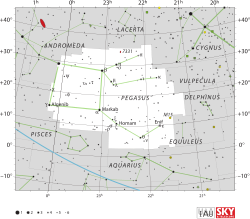| Observation data Epoch J2000.0 Equinox J2000.0 | |
|---|---|
| Constellation | Pegasus |
| Right ascension | 22h 50m 00.19307s[1] |
| Declination | +24° 36′ 05.6926″[1] |
| Apparent magnitude (V) | 3.514[2] |
| Characteristics | |
| Evolutionary stage | Yellow giant |
| Spectral type | G8 III[3] |
| U−B color index | +0.674[2] |
| B−V color index | +0.932[2] |
| Astrometry | |
| Radial velocity (Rv) | +13.54 ± 0.20[4] km/s |
| Proper motion (μ) | RA: +145.240 mas/yr[1] Dec.: −42.396 mas/yr[1] |
| Parallax (π) | 28.934 ± 0.189 mas[1] |
| Distance | 112.7 ± 0.7 ly (34.6 ± 0.2 pc) |
| Absolute magnitude (MV) | +0.432[5] |
| Details | |
| Mass | 2.59±0.05[6] M☉ |
| Radius | 9.32±0.47[7] R☉ |
| Luminosity | 46.9±0.6[8] L☉ |
| Surface gravity (log g) | 2.85±0.03[8] cgs |
| Temperature | 4,961±40[8] K |
| Metallicity [Fe/H] | −0.03±0.02[8] dex |
| Rotational velocity (v sin i) | 0.95±0.45[6] km/s |
| Age | 520±30[6] Myr |
| Other designations | |
| Database references | |
| SIMBAD | data |
Mu Pegasi or μ Pegasi, formally named Sadalbari (/ˌsædəlˈbɛəri/),[10] is a star in the northern constellation of Pegasus. The apparent visual magnitude of this star is 3.5,[2] which is bright enough to be seen with the naked eye even on a moonlit night. Based upon parallax measurements taken by the Gaia spacecraft, it is approximately 113 light-years (35 parsecs) from the Sun.[1]
- ^ a b c d e Cite error: The named reference
DR3was invoked but never defined (see the help page). - ^ a b c d Cite error: The named reference
mnras172_667was invoked but never defined (see the help page). - ^ Cite error: The named reference
aaa508_3_1313was invoked but never defined (see the help page). - ^ Cite error: The named reference
aaa430_165was invoked but never defined (see the help page). - ^ Cite error: The named reference
aaa456_3_1109was invoked but never defined (see the help page). - ^ a b c Cite error: The named reference
jofréwas invoked but never defined (see the help page). - ^ Cite error: The named reference
baineswas invoked but never defined (see the help page). - ^ a b c d Cite error: The named reference
soubiranwas invoked but never defined (see the help page). - ^ Cite error: The named reference
SIMBADwas invoked but never defined (see the help page). - ^ Cite error: The named reference
IAU-LSNwas invoked but never defined (see the help page).
